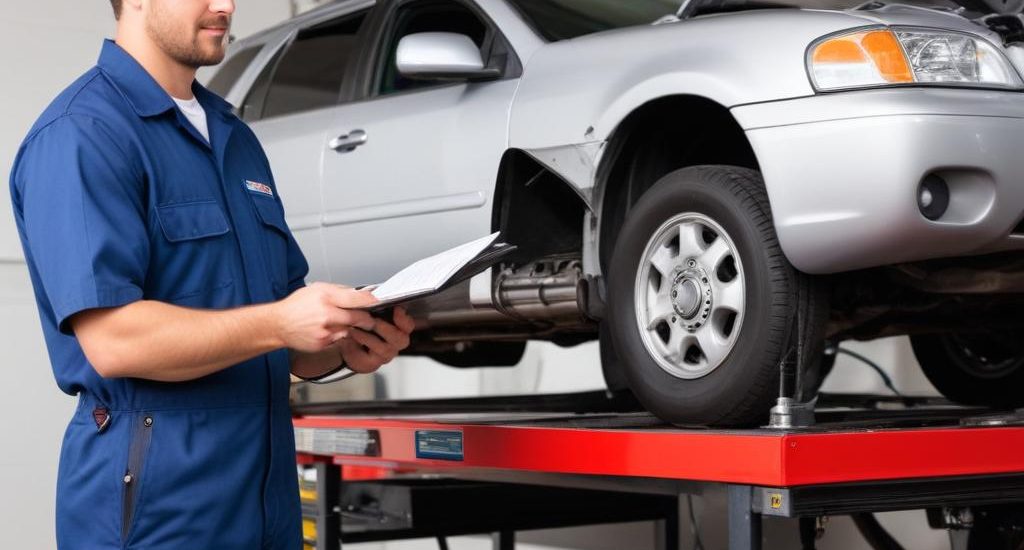To guarantee both the lifetime of your car and road safety, vehicle checks are essential. At inspection stations near me, a meticulously developed vehicle inspection checklist leaves no stone unturned. This extensive guide elucidates each segment of the checklist, helping you understand what to expect during an inspection and why it is crucial for maintaining your vehicle’s health.
Exterior Inspection
Body and Paint Condition
The initial phase involves thoroughly examining the vehicle’s body and paint. We scrutinize for any dents, scratches, or signs of rust. The integrity of the paint is checked for uniformity, ensuring that no underlying issues, such as corrosion, are masked beneath the surface.
Glass and Mirrors
Next, all glass surfaces, including windshields, windows, and mirrors, are inspected. We search for cracks or damage that would hinder visibility. Ensuring mirrors are properly aligned is vital for safe driving.
Lights and Signals
All lights and signals must operate properly. Our checklist includes headlights, taillights, brake lights, turn signals, and hazard lights. We verify that all bulbs are operational and that light casings are free of damage.
Interior Inspection
Upholstery and Seat Condition
Inside the vehicle, the condition of the upholstery and seats is assessed for tears, stains, and wear. Comfortable seating is essential for the safety and comfort of the driver and passengers.
Dashboard and Controls
A thorough check of the dashboard ensures all instruments and switches are operational. This includes the speedometer, fuel gauge, and vital indicators necessary for monitoring vehicle performance.
Heating and Air Conditioning
Climate control systems are tested to ensure they work efficiently. This includes the heating, ventilation, and air conditioning (HVAC) systems, which are crucial for comfort and safety.
Under the Hood
Engine and Transmission
The engine and transmission undergo meticulous inspection. Signs of leaks, unusual noises, and vibrations are assessed, as proper functioning is vital for vehicle performance.
Fluid Levels and Conditions
We check the levels of all fluids, including power steering, coolant, brake, gearbox, and engine oil. Ensuring these fluids are optimal is essential for smooth vehicle operation.
Battery and Electrical System
Corrosion, connections, and charge levels are checked in the battery and electrical system. A reliable electrical system is necessary for starting the vehicle and powering various components.
Under the Vehicle
Exhaust System
The exhaust system is checked for leaks and damage. It must be in good condition to reduce emissions and operate smoothly.
Suspension and Steering
We examine suspension and steering components for wear and damage. Proper functioning is crucial for safe driving.
Brakes and Rotors
We assess rotors, calipers, and brake pads for wear and functionality. Effective brakes are critical for vehicle safety and control.
Tires and Wheels
Tire Tread and Condition
Tire treads are checked for depth and wear. Worn tires can lead to poor handling and increased stopping distances, posing a safety risk.
Alignment and Balance
Proper alignment and balance of the wheels are verified to ensure smooth driving. Misalignment can cause uneven tire wear and vibrations.
Wheel Integrity
The integrity of the wheels is examined for cracks or damage. Maintaining well-functioning wheels is vital for safety.
Safety Features
Seatbelts and Airbags
All seatbelts and airbags are tested for functionality, enhancing occupant safety in the event of a collision.
Horn and Warning Lights
The horn and dashboard warning lights are checked to ensure they work correctly. These features are essential for alerting the driver to potential issues.
Safety Sensors and Cameras
Modern vehicles come equipped with various safety sensors and cameras, which are tested to ensure proper operation.
Road Test
Acceleration and Deceleration
During the road test, we evaluate the vehicle’s acceleration and deceleration to identify any issues with the engine or braking system.
Handling and Stability
The vehicle’s handling and stability are assessed in various driving conditions to ensure safe reactions to steering inputs.
Noise and Vibration Analysis
Any unusual noises or vibrations are noted during the road test, indicating underlying mechanical issues.
Documentation and Reporting
Inspection Report Details
A thorough report is produced upon completion of the inspection. This report outlines all findings, including identified issues and recommended repairs.
Common Findings and Recommendations
We provide a summary of common findings and tailored recommendations based on the vehicle’s specific condition, helping owners prioritize necessary repairs.
Importance of Regular Inspections
Regular car inspections are necessary to maintain the safety, performance, and value of a vehicle. They help identify potential problems early, preventing costly repairs and ensuring the vehicle remains roadworthy.
By adhering to this comprehensive vehicle inspection checklist, car inspection stations guarantee that every vehicle receives a meticulous evaluation, ensuring safety, reliability, and peace of mind for the owner. For those seeking car inspection services near me, this thorough process is essential.


